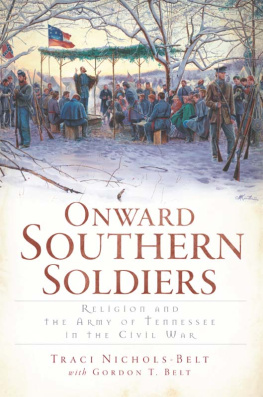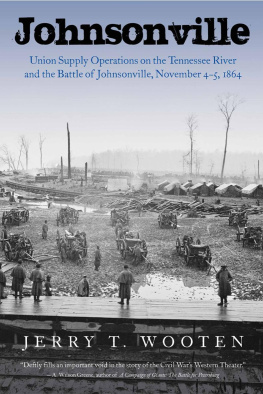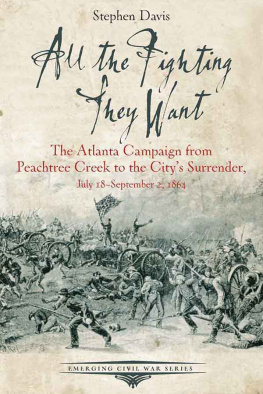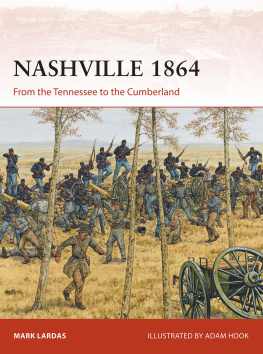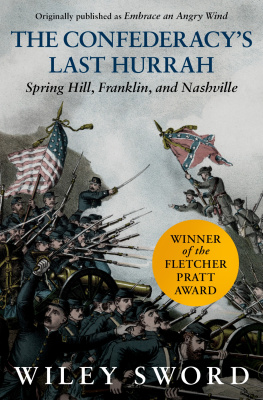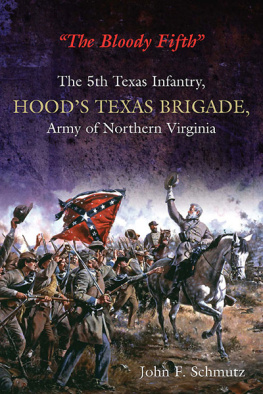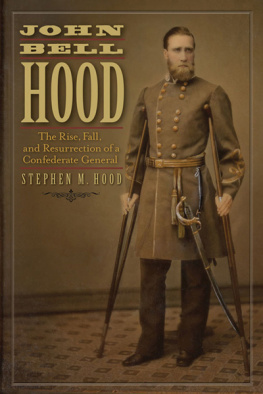
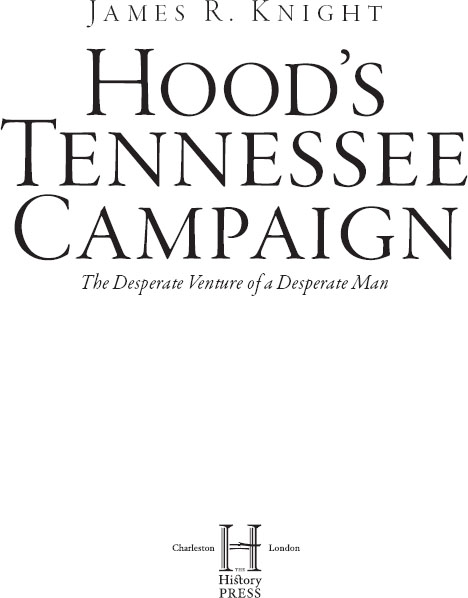
Published by The History Press
Charleston, SC 29403
www.historypress.net
Copyright 2014 by James R. Knight
All rights reserved
First published 2014
e-book edition 2014
ISBN 978.1.62585.130.7
Library of Congress CIP data applied for.
print edition ISBN 978.1.62619.597.4
Notice: The information in this book is true and complete to the best of our knowledge. It is offered without guarantee on the part of the author or The History Press. The author and The History Press disclaim all liability in connection with the use of this book.
All rights reserved. No part of this book may be reproduced or transmitted in any form whatsoever without prior written permission from the publisher except in the case of brief quotations embodied in critical articles and reviews.
Contents
Authors Foreword
Hoods Tennessee Campaign was a huge undertaking, involving at least eighty thousand combat troops marching and fighting over almost five thousand square miles of Middle Tennessee countryside for almost six weeks. For the people of Middle Tennessee, it was the most significant event of the Civil War that they witnessed personally. Obviously, a work of this scope can only hope to provide a brief overview of this, the Confederacys last major offensive. Unfortunately, that means that most of the campaigns major events and most interesting characters will get much less attention than they deserve. Please see Sources and Suggested Reading for more details on specific parts of the campaign.
There are many excellent works that examine one area or another of the campaign, and I have tried to consult as many as I could. For the backbone of the story, however, I relied primarily on three sources:
Eric Jacobsons For Cause and for Country, which has become the standard reference for the early part of the campaign, especially from the Tennessee River through Spring Hill and Franklin.
James Lee McDonoughs Nashville: The Western Confederacys Final Gamble, which examines both armies operations during the first two weeks of December 1864 and gives details of the two-day battle.
Derek Smiths In the Lions Mouth, which details the one-hundred-mile-long retreat back to the Tennessee River.
For the multitude of detail about the armies and their operations and the communications of all the major figures, the Official Records, Volume 45, Parts I and II, were open on my desk and my computer constantly.
There are always people to thank, and as this is my fourth book in the Sesquicentennial Series, they are mostly the usual suspects. First and foremost, Id like to thank all the folks at the Battle of Franklin Trust (BOFT), which operates the Carter House and Carnton Plantation in Franklin, Tennessee, for being a joy to work with and giving an old retired guy such a great part-time job. It also came in handy that Eric Jacobson, my friend and my boss at BOFT, knows more about this campaign than anybody else I know.
Brian Allison, former historian at the Travellers Rest Historic Site in Nashville, answered a lot of questions and once gave an impromptu seminar for myself and a Civil War buff from New Zealand over lunch. Brian was also my go-to guy for details and statistics on the Battle of Nashville.
Finally, thanks to the folks at The History Press for letting an old retired FedEx pilot try it one more time.
James R. Knight
Franklin, TN
Prologue
the widest river in the world.
BAINBRIDGE, ALABAMAMIDNIGHT, DECEMBER 28, 1864
It was dark and cold that night as Nathan Bedford Forrest began sending the men of his ad hoc command across the Tennessee River on a pontoon bridge. A week earlier, at Columbia, Tennessee, Confederate general John Bell Hood had made one of the best decisions of his career by putting Forrest in charge of covering the last sixty-five miles of the Army of Tennessees retreat from the disaster at Nashville. With a cobbled-together force of his cavalry and some infantry led by Major General Edward Cary Walthallfewer than five thousand men in allForrest had fought four critical delaying actions over the last five days, buying Hood the time he needed to save what was left of his army. Now, with his rear guard responsibilities completed, it only remained for Forrest to save his own men from the pursuing Federal forces.
The pontoon bridge that lay in front of Forrests men was a rickety affair at best, but for the last day and a half, it had held together, giving Hoods army a means to reach the relative safety of the south bank of the river. Now, Forrests troopers were told to dismount and lead their horses across, and one of them later said that the bridge seemed as if it were nothing but inch boards laid on top of the water. Another, who had an injured leg and elected to stay mounted that night, said that the bridge was in a swing, jumping up and down, and that the Tennessee seemed to be the widest river in the world.
By the middle of the day on the twenty-eighth, the last Confederates were across the river, and the engineers had cut the pontoons loose from the north bank. The nearest Federal troopsa special cavalry unit under Colonel George Spalding of the Twelfth Tennessee Cavalrywere still a few miles away. So ended the last Confederate offensive of the Civil War. The war in the Deep South would continue for another five months or so, but the Confederate Army of Tennessee was, for all intents and purposes, finished. The name remained, and many of its battered units and senior officers would fight on until the end with other commands, but the old Army of Tennessee that had fought at places like Stones River, Chickamauga, Missionary Ridge, Atlanta, Franklin and Nashville never took the field again.
Fifty-eight days earlier, when it began to arrive on the Tennessee River at Tuscumbia and Florence, Alabama, the Confederate Army of Tennessee was only a shadow of the force that had opposed Major General William T. Shermans Federal army in northern Georgia at the beginning of the Atlanta Campaign, six months earlier. During that brutal summer, first under General Joseph E. Johnston and then under General John Bell Hood, its current commander, the army had lost northern Georgia, the city of Atlanta and almost half of its combat force. As they settled into camps on both sides of the Tennessee River at the beginning of Novemberragged, hungry, exhausted and, in many cases, barefootthe men resembled nothing so much as an army of homeless people. Even so, the nucleus of a veteran fighting force remained and was still quite dangerous.
In recent years, Hoods Tennessee Campaign has come to be viewed by many as a hopeless enterprise that was doomed from the beginninga sort of quixotic dream of a delusional commander seeking to restore past glories. In early November 1864, however, the presence of Hoods army on the Tennessee River, just over one hundred air miles from the defenses at Nashville, was taken very seriously by everyone on the Northern side, from Major General George Thomas, commanding at Nashville, to General Grant and the rest of the Federal high command.
The reason the threat of an offensive by Hoods army was viewed with some alarm by the Federal high command was simple. The Army of Tennessee began to arrive at Florence and Tuscumbia, Alabama, on October 31, and ragged as it was, Hood could still field about thirty thousand effective troops. When joined by Nathan Bedford Forrests cavalry, that number would rise to at least thirty-three thousand men of all armsmany of them hardened combat veterans. On November 1, there was no Federal force in Middle Tennessee that could have opposed an army of the size Hood could muster.
Next page



